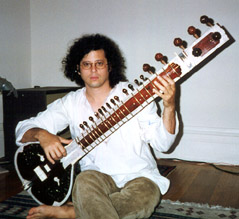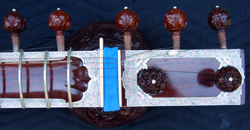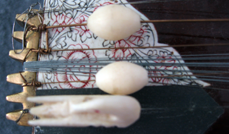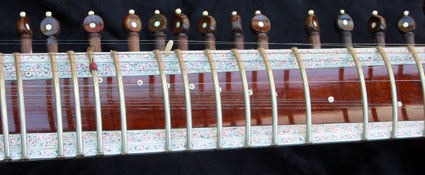How to Tune a Sitar
See additional resources at bottom of document for more in depth information. I also provide recording services at Cosmic Circuit in El Cerrito, California and am Apple Logic Pro certified.
Obtaining a Sitar
In the winter of 1998 I traveled to Nepal and India. I purchased a sitar on the last day of my stay in Dehli, India so as not to have to deal with traveling with the large instrument while backpacking around the country. The trials and tribulations of purchasing a high quality sitar instrument in India is not an easy one – perhaps down the road I will provide some insight and ideas for other people pursuing such an adventure. My recommendation when purchasing a musical instrument is to buy the best quality instrument you can afford. In India it is often difficult to judge the quality of these instruments so it is best to do as much research as you can ahead of time, talk to other musicians and travelers and visit as many shops as you can. I recommend purchasing a fiberglass strong flight case if you need to take your sitar on an airplane since the gourds are very fragile.

Background
The sitar is a modal instrument – meaning that depending on the key you are playing in you may need to re-tune the instrument. Also, to complicate matters if you are playing certain scales you will need to move certain frets to play certain notes. (note: frets are moveable on a sitar).
Sitting Position
The ideal position to play the sitar is to sit in a half lotus postion – and rest the gourd on the bottom of your foot. You may want to take off your shoes. Hold the sitar at a 45 degree angle. Place a mizrab on the tip of your index finger. Keep the thumb of your picking hand touching the top base side of the instrument. I recommend the mizrabs with a plastic coating because the one’s without the plastic tend to dig into your finger and can be painful.
Tuning the Sitar
The task of tuning the sitar can be intimidating, time consuming and laborious. Most sitars have between 18-20 strings (my particular sitar has 20 strings – 7 main and 13 sympathetic – other sitars often have 11 sympathetic). It can take a significant of time to completely tune the instrument properly. The tuning pegs are simple wood – no highly enginnered gears like the ones found on a guitar. The wood pegs combined with the instrument sliding in and out of tune can be frustrating for a beginner. I recommend purchasing an electronic chromatic tuner that contains a built in microphone that can detect the note of the string played. You can also purchase a chromatic tuner app for your mobile smart phone (iPhone, Android phone) that can use the mic of the phone to detect the note of the string.
A sitar can be tuned a variety of ways and can be tuned to different keys usually from B to D. A fairly standard tuning is the key of C; however, certain performers such as Ravi Shankar tune their sitars to C#. Also note that various ragas demand that the sitar be re-tuned to a different key. For most beginners, especially westerners, it is recommended to start out with the key of C.
Middle C
When tuning a sitar first locate the middle C note on a keyboard, piano or guitar. If you have a tuned guitar, the middle C note is located on the 2nd string (B string) 1st fret. On a full sized midi keyboard (88 keys) or piano the middle C note is located in the middle of the piano. Some midi keyboard manufacturers, such as M-audio, have middle C labelled as ‘C3’ on their full sized keyboards. You will use the middle C note as a reference point to tune the sitar. The 2nd, 4th, 6th and 7th main strings of your sitar will be tuned to the tonic note.
Also note that Indians use a relative tuning system. the tonic note is ‘Sa’. Thus, if you are tuning your sitar to the key of ‘C’, the tonic note ‘Sa’ will be a ‘C’. When tuning it is a good idea to find the C note using a tuner or other instrument (guitar, piano, etc.) and tune these strings first.
Comparison of Indian Scale to Western Major Scale
| bilaval that | Sa | Re | Ga | Ma | Pa | Dha | Ni | Sa |
| Western major scale (solfege) | Do | Re | Me | Fa | So (or Sol) | La | Ti (or Si) | Do |
| C major scale | C | D | E | F | G | A | B | C |
| Numeric western scale | 1 | 2 | 3 | 4 | 5 | 6 | 7 | 8 |
Tuning the 7 Main Strings on a Sitar
(Pancham-Kharaj tuning popularized by Ravi Shankar)


| Strings on Sitar: | Indian Note Name: | Western Note: | Note equivalent on a Guitar |
| 1st (string closest to floor) | Ma | F note one octave below Middle C | 4th string 3rd fret |
| 2nd | Sa | C note one octave below Middle C | 5th string 3rd fret |
| 3rd | Pa | G note | 6th string 3rd fret |
| 4th | Sa | C note two octaves below Middle C (On some sitars this string is tuned the same as the 2nd string). * | For the thicker sitar string, the note is not available on a guitar because it is lower than the low open 6th string on the guitar. If using the lighter gauge sitar string, then the equivalent is the 5th string 3rd fret. |
| 5th | Pa | G note one octave above the 3rd string | 3rd string open |
| 6th | Sa | C note – Middle C | 2nd string 1st fret |
| 7th | Sa | C note one octave above Middle C | 1st string 8th fret |
* If 4th string of sitar is a thicker gauge string that the 3rd string tune the 4th string two octaves below Middle C – if it is a thinner gauge string tune it to the exact same note as the 2nd string – C note one octave below Middle C.
Purpose of the Sympathetic Strings
The ‘resonance’ or vibratory tone of the sitar comes from the vibrations of the sympathetic strings. You normally do not play these strings except for a special effect. If the sympathetic strings are tuned properly the sympathetic strings will vibrate and should give off a nice full resonance when playing particalar notes on the main strings. Some sitars have a second gourd that attaches to the back of the head of the instrument. My sitar has a removable second gourd that screws on. A second gourd will make your instrument have a fuller resonance.
Tuning Sympathetic Strings on a Sitar for the Key of C
The tuning of the sympathetic strings can vary but basically you typically want to tune these strings to the same scale or to the same notes of the raga that you are playing. If you are playing a raga that uses different notes than the western major scale (Indian bilaval that) that you should retune your sympathetic strings to the same notes as the scale. Also note that many sitars have only 11 sympathetic strings whereas others have 13. There are varying methods for tuning these strings – start simple when beginning. I would recommend for absolute beginners to not worry about tuning the sympathetic string because of the difficulty and time involved. Just try to tune the main strings first and learn some of the basic scales and picking techniques.

Notes on the Sympathetic Strings (for Bilaval Tuning)
| Sympathetic String | 1st | 2nd | 3rd | 4th | 5th | 6th | 7th | 8th | 9th | 10th | 11th | 12th | 13th |
| Eastern Note Name | Sa | Sa | Ni | Sa | Ra | Ga | Ma | Pa | Dha | Ni | Sa | Ra | Ga |
| Western Note Name | C – middle C | C – middle C | B | C – middle C | D | E | F | G | A | B | C – one octave higher than middle C | D | E |
Various Sympathetic Tuning methods for a sitar with 13 strings:
Scheme I:
Indian: S N S R G m P D N S R G m
Western: C B C D E F G A B C D E F
Scheme II:
Indian: N S P R G m P D N S R G m
Western: B C G D E F G A B C D E F
Scheme III:
Indian: P D N S R G m P D N S R G
Western: G A B C D E F G A B C D E
Quick Tuning Cheating Method
Often you will want to play the sitar but by the time you have fully tuned it the feeling and inspiration is gone. In these situations, my recommendation is to just tune the 1st two strings main strings – F & C and the chicari strings both to C. This should take less than a minute. 98% of your playing will be on these strings.
West Adopts the East
During the 1960’s western music began to reflect the new interest in eastern spirituality. Norwegian Wood, on the Beatles 1965 Rubber Soul release, was one of the first popular western songs to have a sitar line. In 1966, the Rolling Stones’s founder Brian Jones used a sitar riff in Paint It Black on the U.S. release of Aftermath. In 1967 the Beatles released Sgt. Pepper’s Lonely Hearts Club Band with the Indian influenced track Within You Without You featuring George Harrison on sitar and vocals. Other Indian instruments – a dirubala, tamboura and tabla are heard on the track. Ravi Shankar’s inspired performance at the 1967 Monterey Pop Festival and his association with the Beatles gave the sitar and Indian music acceptance under the exploding 60’s counter culture. The Concert for Bangladesh, organized by George Harrison shortly after the Beatles breakup, took place on August 1, 1971 at Madison Square Garden with a performance by Ravi Shankar (as well as appearances from Eric Clapton (guitar), Ringo Starr (drums), Billy Preston (keyboards), Leon Russell (piano), Bob Dylan, Jim Keltner (drums), Klaus Voormann (bass), Jesse Davis (guitar), Badfinger (acoustic guitars) & more.
Additional Resources on sitars & Indian music
Ali Akbar Khan School of Music – School located in San Rafael, California
Ashwin Batish – Santa Cruz, California based sitar instructor.
Raganet
My Music My Life Ravi Shankar, copyright 1968 Vikas Publishing House PVT LTD, ISBN 0-7069-8753-5, (hard to find)
India Musica – An Interactive Guide to Hindustani Music – Windows based CDROM by Magic Software (hard to find)
Sitar Tuning and Maintenance Silver Bush Music
Buckingham Music – Online Tutorials for Sitar, Tuning the Sitar
Introduction to Sitar, by Harihar Rao, copyright 1967, Peer International Corporation, 02-016504-930
Learn to Play on Sitar, Ram Avtar ‘Vir’, Pankaj Publications, Revised Edition 1998. ISBN 81-87155-14-0
Maestros of India – CD of traditional sitar, flute & Indian music. Purchased in Pushkar, India (hard to find).
Terms
mizrab – finger pick used for sitar. Usually made from 10 gauge piano wire.
chicari – The 6th & 7th main strings on the sitar that are played simultaneously.
comel – lower note by a half step. A flatted note.
